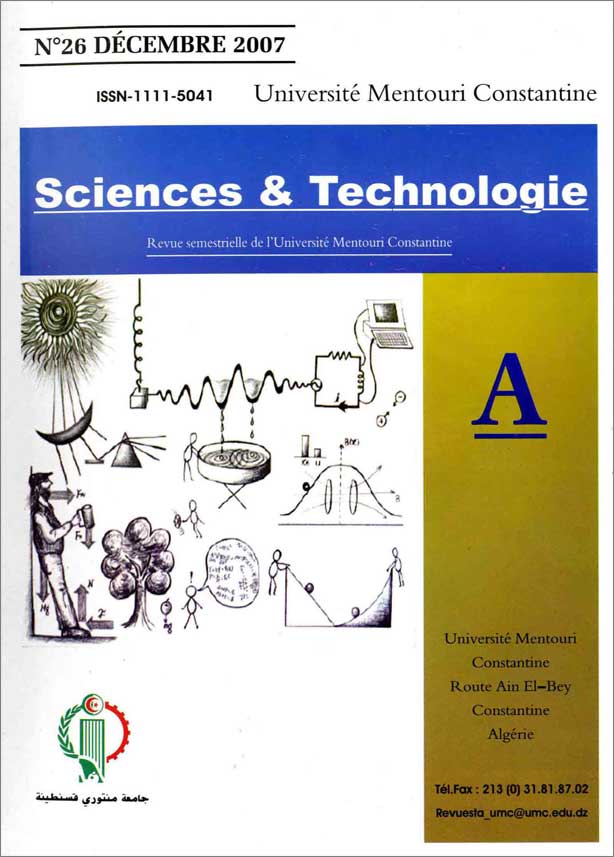PHOTO-ELECTROCHEMICAL QUANTUM EFFICIENCY OF TiO2 THIN FILMS : EFFECT OF CRISTAL STRUCTURE, PLASMA HYDROGENATION AND SURFACE PHOTOETCHING
الكلمات المفتاحية:
crystal structure، hydrogenation، photoetching، photoelectrochemical quantum efficiencyالملخص
The use of semi-conducting materials in the photoelectrochemical detoxification of water became a very important research field. For this purpose, TiO2 nanostructures thin films with size of 18 nm to 45nm have been synthesized at low temperature. It is found by means of cyclic voltametry and coulometry measurements that the best photoelectrochemical quantum efficiency under UV monochromatic light with a wavelength of 365 nm and a solution of NaOH 0.1N is obtained in the case of thermal oxidation deposition method which can reach 28% compared to ultrasonic spray and dip coating methods of which the quantum is less than 20%. The crystal structure has an influence on the photo-degradation of methanol. The crystal structure which is recommended for this task is the anatase one, especially in the dipping case when the quantum increases after addition of methanol more than twice compared to the solution of NaOH without methanol. The photoelectrochemical quantum efficiency of these films is related to the number of dips and annealing under air at 550°C during one hour. The annealing has no effect on the quantum efficiency of the films, but decreases there photocatalytic activity as showed by the measure of the photocurrent related to methanol photodegradation. The annealing has no effect on the crystal structure of the material. The impedance spectroscopy of six dips deposited films with and without methanol shows that the annealing increases the doping and weakly decreases the film quantum efficiency. This implies, the importance of surface morphology which the rough is decreasing as showed by scanning electron microscopy. The effect of the precursor concentration in ethanol have been investigated by using films, synthesized at T=550°C. The quantum efficiency increases weakly according the precursor concentration. It tends towards a saturation at great concentrations of precursor. In Na OH with methanol added, it passes by a maximum at a proportion 1 to 9. The cyclic voltametry and the impedance spectroscopy showed that the incorporation of hydrogen by plasma in TiO2 films decreases photoelectrochemical quantum efficiency in NaOH electrolyte and increases the doping concentration. The photoelectrochemical quantum efficiency in NaOH electrolyte of photoetched films in H2SO4 at full UV light increased two times greater than of non photoetched one (26.7% versus 14%).
التنزيلات
المراجع
A. Fujishima, K. Honda, Nature Vol. 238 july, 1972, 37-38
A. Fujishima, T. Rao, D. Tryk, journal of photochemistry and photobiology C: photochemistry reviews1 (2000), 1-21.
P. Salvador, J. Electrochem. Soc., Vol 128 (9), 1981, pp. 1895-1900.
K. Bernhard and A. J. Bard, Journal of the American Chemical Society, Vol. 100, n°19, September 13, 1978, pp. 5985-5992.
M. R. Hoffmann, S. T. Martin, W. Choi, D. W. Bahnemann, Chem. Rev. 95 (1995), 69-96.
J. Yu, X. Zhao, Materials Research Bulletin 35 (2000) 1293-1301.
D. Zane, F. Decker and G. Razzini, Electrochimica Acta. Vol 38, N°1, 1993 pp. 37-42.
M. Dolata, P. Kedzierzawski and J. Augustynski, Electrochimica Acta, Vol. 41, N°7/8, 1996, pp. 1287-1293.
A. Shiga, A. Tsujiko, T. Ide, S. Yae and Y. Nakato, J. Phys. Chem. B 102, 1998, 6049,6055.
H. Cui, H-S. Shen, Y-M. Gao, K. Dwight and A. Wold, Mat. Res. Bull., Vol. 28, 1993, pp. 195-201.
A. Wahl, M. Ulmann, A. Carroy and J. Augustynski. J. Chem. Soc., Chem. Commun., 1994, pp. 2277-2778.
J. Augustynski, Electrochimica Acta, Vol. 38, N°1, 1993, pp. 43-46.
A. Sclafani, J. M. Hermann. J. Phy. Chem. 1996, 100, 13655-13661.
G. S. Hermann, Y. Gao, T. T. Tran, J. Osterwalder . Surface Science Vol. 447 N°1 (2000) 201-211.
Z. Zhang, C. Wang, R. Zakaria, J. Y. Ying, J. Phy. Chem. B 1998, 102, 10871-10878.
Rajshwar K., Singh P. and Dubow J., Electrocimica acta, vol 23, 1978, pp 1117-1144
L. Kavan and M. Cratzel, Electrochimica Acta, Vol.40, N°5, 1995, pp. 643-652.
S. E. Gilbert and J. Kennedy, J. Electrochem. Soc. September 1988, pp. 2385-2386.
Y. Nakato, H. Akanuma, J-I. Shimizu, Y. Magari, J. Electroanal. Chem., 396 (1995) 35-39.







